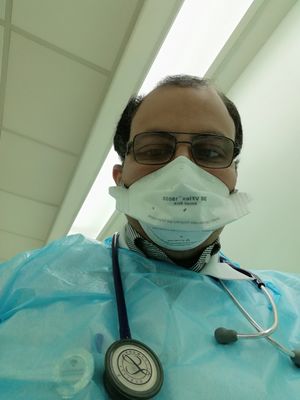Infection Prevention and Control: Difference between revisions
No edit summary |
No edit summary |
||
| Line 19: | Line 19: | ||
== Examples of Infection Control == | == Examples of Infection Control == | ||
There are many areas in which infection control can be implement: <ref name=":0" /><ref name=":1" /><ref name=":2" /> | There are many areas in which infection control can be implement: <ref name=":0" /><ref name=":1" /><ref name=":2" />[[File:Protect-Your-Hands.png|frameless]] | ||
* Hand hygiene | * Hand hygiene | ||
* Prevention of surgical site infections | * Prevention of surgical site infections | ||
Revision as of 14:00, 13 March 2020
This is page is currently under updating . Sorry for any inconvenience.
Original Editor '- Rewan Elsayed Elkanafany
Top Contributors - Shaimaa Eldib, Kim Jackson, Naomi O'Reilly, Richard Benes, Rachael Lowe, Lucinda hampton, Shreya Pavaskar, Wanda van Niekerk, Rewan Elsayed Elkanafany, Tarina van der Stockt, Jess Bell, Admin, Khloud Shreif, Tony Lowe, Stacy Schiurring, Tolulope Adeniji, Laura Ritchie, Simisola Ajeyalemi and Vidya Acharya
Introduction[edit | edit source]
Infection prevention and control (IPC) is a scientific approach and practical solution designed to prevent harm caused by infection to patients and health workers. It is essential in infectious diseases, epidemiology, social science and health system strengthening. IPC plays a unique role in the patient safety and the quality of universal health coverage, as it is relevant to health care-workers and patients[1].
What is an Infection?[edit | edit source]
An infection happens when germs enter the body, increase in number, and cause a reaction of the body.[2][3]
Infection Control and Prevention[edit | edit source]
Infection control and prevention is a global issue,especially in healthcare facilities where we have a duty to keep patient's who may have lower immune defences, safe and free from infection. Infection control and prevention can work effectively using 6 main themes[1]:
- Leadership,
- connecting and coordinating
- Campaigns and advocacy
- Technical guidance and implementation
- Capacity-building
- Measuring and learning
Examples of Infection Control[edit | edit source]
There are many areas in which infection control can be implement: [1][2][3]
- Hand hygiene
- Prevention of surgical site infections
- IPC to combat antimicrobial resistance
- Injection safety
- Burden of health care-associated infections
- Ebola response and recovery
- IPC country capacity-building
- Prevention of sepsis and catheter-associated bloodstream infections
- Prevention of catheter-associated urinary tract infections.(CAUTI)
- Isolation precautions Multidrug-resistant organisms (MDRO)
- Intravascular catheter-related infection (BSI)
- Organ transplantation Surgical site infection (SSI)
- Norovirus Pneumonia prevention Dialysis
- Infection Control in Healthcare Personnel
- Post exposure Prophylaxis in Healthcare Workers
Infection Control for Acute Care Hospitals[edit | edit source]
To assist in the assessment of infection control programs and practices in acute care hospital the Centers for Disease Control and Prevention suggest that management can be divided into 4 sections:
it s divided into 4 sections:
- Section 1: Facility Demographics
- Section 2: Infection Control Program and Infrastructure
- Section 3: Direct Observation of Facility Practices (optional)
- Section 4: Infection Control Guidelines and Other Resources
Resources[edit | edit source]
The following resources expand further on the four sections mentioned above https://www.cdc.gov/infectioncontrol/pdf/icar/hospital.pdf
References[edit | edit source]
- ↑ 1.0 1.1 1.2 WHO.infection prevention&control .Available from:https://www.who.int/infection-prevention/about/ipc/en/
- ↑ 2.0 2.1 CDC centers for disease control and prevention.infection control. Available from:https://www.cdc.gov/infectioncontrol/index.html
- ↑ 3.0 3.1 Wilson J. Infection control in clinical practice. Elsevier Health Sciences; 2006 Jun 21.
- ↑ Health portal Infection control, Available from: https://www.youtube.com/watch?v=QgqTW0FjN08 (last accessed 22.4.2019)







